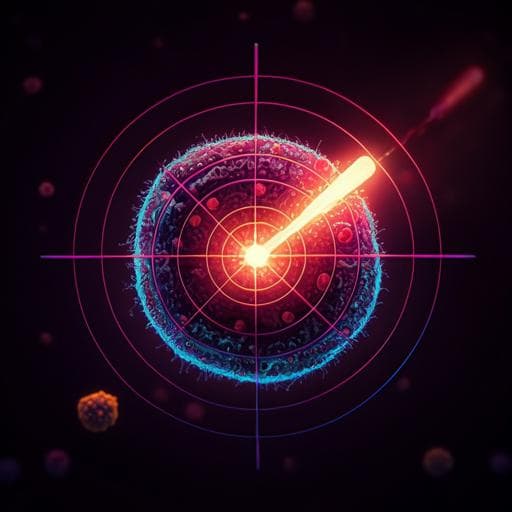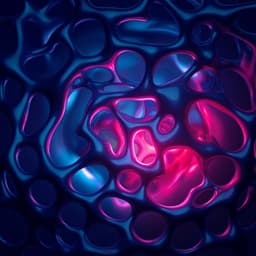
Medicine and Health
Self-reporting photodynamic nanobody conjugate for precise and sustainable large-volume tumor treatment
Y. Chen, T. Xiong, et al.
Discover the innovative development of MNB-Pyra Nbs, a groundbreaking photodynamic conjugate that effectively suppresses tumors. This pioneering research by Yingchao Chen, Tao Xiong, Qiang Peng, Jianjun Du, Wen Sun, Jiangli Fan, and Xiaojun Peng showcases how these photosensitizers can be activated for self-reporting PDT, making a significant impact in cancer therapy.
~3 min • Beginner • English
Introduction
Photodynamic therapy (PDT) offers minimally invasive, repeatable cancer treatment with precise spatiotemporal control but is hindered by off-target toxicity, tumor hypoxia, and inadequate accumulation/retention of photosensitizers at tumor sites. Antibody–drug conjugates improve tumor specificity; however, monoclonal antibodies are expensive, large, and difficult to modify site-specifically. Nanobodies (Nbs), small and stable single-domain antibodies, can be bacterially produced and engineered, offering better tumor penetration but suffer from rapid in vivo clearance (t1/2 ~60–90 min), limiting photosensitizer retention and efficacy, particularly in large tumors. The authors target EGFR using the 7D12 nanobody and a type I photosensitizer (MNB-Pyra) linked via a ROS-cleavable linker to create a conjugate that can self-report activation (fluorescence recovery) and achieve precise, long-term retention of released photosensitizer at the tumor after light activation, enabling sustained PDT from a single dose while minimizing systemic phototoxicity.
Literature Review
PDT has seen clinical use (e.g., porphyrins, phthalocyanines) but suffers from non-selectivity, phototoxicity, and hypoxia limitations. ADC strategies using mAbs (e.g., cetuximab–IRDye700DX) have advanced targeting but face challenges in conjugation specificity, cost, and poor tumor penetration. Nanobody-targeted PDT was pioneered in 2014, with subsequent studies showing efficacy in head and neck cancer and trastuzumab-resistant HER2-positive cancer. Prior nanobody-PDT largely used IRDye700DX (type II singlet oxygen generator), which is impacted by hypoxia. Type I photosensitizers like benzophenothiazine derivatives (morpholine-modified Nile Blue) generate superoxide via electron transfer and can be effective under hypoxia. The need remains for simple, site-specific nanobody conjugation, sustained intratumoral photosensitizer presence for large tumors, and minimized systemic phototoxicity.
Methodology
Design and synthesis: The type I photosensitizer MNB-Pyra (morpholine-modified Nile Blue linked to a pyrazolone via a ROS-cleavable linker) was synthesized; a dimer form (self-quenched) can form via a Knoevenagel–Michael tandem reaction with aldehydes. Computational modeling (conformational search via GFNn-xTB; geometry optimization with B97-3c; RI-wB97M-V/def2-TZVP single points with SMD solvent) characterized the dimer as a π-stacked foldamer (center-to-center distance 4.4 Å, flip angle 55.2°, 99.8% abundance), explaining dimerization-caused quenching (DCQ). Photophysics and ROS: Absorbance and fluorescence measured in PBS; quantum yields determined; ROS evaluated using DPBF and ABDA for 1O2 (negligible), DHE and DHR123 for O2•− (efficient), and EPR with DMPO adducts. Photostability tested under 630 nm irradiation (50 mW/cm2, 60 min). Light-triggered cleavage assessed by spectral changes and HRMS to detect monomer (m/z ~479.1568 [M]+). Nanobody conjugation: 7D12 nanobody was engineered with a C-terminal aldehyde (7D12-fGly) using formylglycine-generating enzyme. Site-specific in situ dimerization of two MNB-Pyra molecules to the aldehyde tag was performed in MES buffer (pH 6.5) at room temperature to yield MNB-Pyra Nbs (1:2 Nb:photosensitizer). Characterization by SDS-PAGE (weak fluorescence band, no major migration), HPLC-HRMS (7D12-fGly mass 17990.770; conjugate 19536.219), showing >95% conjugation in 24 h. DLS measured hydrodynamic diameters (7D12-fGly 5.3 nm; MNB-Pyra Nbs 6.1 nm). Binding affinity to EGFR measured by biolayer interferometry (BLI): KDs 1.79 ± 0.27 nM (7D12-fGly) and 24.33 ± 0.65 nM (conjugate). Spectroscopy of conjugate showed DCQ-like behavior (blue-shifted absorbance to 600 nm, Φf ~0.8%, fluorescence recovery upon 630 nm irradiation; release efficiency ~83%, monomer m/z 479.1566). In vitro studies: Cell lines with varying EGFR (A431 high; HeLa moderate; A549 and NIH-3T3 low/neg) determined by Western blot. Cytocompatibility assessed (24 h, dark). Uptake by CLSM and flow cytometry (0.2 µM, up to 2 h). Subcellular localization with LysoTracker (Pearson’s r 0.871). ROS generation in cells under normoxia and hypoxia using DCFH-DA and DHE. PDT assays: IC50s determined under 630 nm irradiation (30 mW/cm2; 10–20 min), including hypoxia (2% O2). Apoptosis measured with Annexin V-FITC/PI by microscopy and flow cytometry. Wound-healing assay after treatment (0.5 µM, 20 min irradiation). Self-reporting assessed by fluorescence increase after illumination in cells and by flow cytometry. In vivo studies: BALB/c nude female mice (5–6 weeks). A431 and HeLa subcutaneous xenografts. Dosing: intravenous injections of MNB-Pyra Nbs (0.3–0.5 mM; 100–200 µL). Real-time fluorescence imaging post-injection up to 24 h; organ distribution at 24 h. Bilateral tumor model to compare irradiated vs non-irradiated tumors (630 nm, 30 mW/cm2, 20 min). Long-term retention: after systemic dosing and irradiation, tumor fluorescence tracked up to 120 h (5 days) with dissection. Intratumoral injection of MNB-Pyra to observe ROS-responsive linker cleavage kinetics. HPLC quantification of tumor accumulation at peak (6.3 µM). PDT efficacy in large tumors (initial volume ~350 mm3): single round (day 1) vs three rounds (days 1–3) of irradiation at 630 nm, 50 mW/cm2, 20 min. Endpoints: tumor volume over 14–16 days; tumor weights; TUNEL, H&E, Ki-67 IHC; body weight; major organ H&E. Sample sizes: typically n = 4–5 mice per group as specified.
Key Findings
Photophysics and ROS: MNB-Pyra monomer absorbs at 645 nm and emits at 708 nm; dimer is blue-shifted (~600 nm) with strong fluorescence quenching (Φf decreases from 4.6% to 0.9%). Computational modeling supports a π-stacked dimer foldamer (4.4 Å, 55.2°). Both MNB-Pyra and the dimer produce superoxide (O2•−) efficiently (DHE/DHR123 assays; EPR DMPO adduct observed), with negligible singlet oxygen. Dimer depolymerizes upon 630 nm irradiation with fluorescence recovery and release of monomer PS (HRMS m/z ≈ 479.1568). Conjugate characterization: Site-specific conjugation yielded a 1:2 nanobody:photosensitizer ratio (7D12-fGly 17990.770 Da to 19536.219 Da), >95% efficiency in 24 h. DLS sizes: 5.3 nm (7D12-fGly) vs 6.1 nm (conjugate). EGFR binding remained in the nanomolar range (KD 1.79 ± 0.27 nM vs 24.33 ± 0.65 nM after conjugation). Conjugate showed DCQ-like spectral features (absorption blue shift to 600 nm, Φf ~0.8%) with light-triggered fluorescence recovery; release efficiency ~83%. In vitro targeting and PDT: High uptake and fluorescence in EGFR-positive A431 and HeLa cells; negligible in A549, NIH-3T3. Cytocompatible in dark (>90% viability across cell types). Robust ROS generation under normoxia and hypoxia. Potent PDT cytotoxicity: A431 IC50 0.2 µM (normoxia) and 0.4 µM (hypoxia). EGFR selectivity: strong killing in A431 and HeLa (IC50s 0.2 and 0.3 µM) with minimal effect on A549 and NIH-3T3; MNB-Pyra dimer lacked selectivity. Wound healing suppressed in A431 and HeLa (24 h rates 17% and 13%); complete healing in A549 and NIH-3T3. Apoptosis indicated by Annexin V-FITC/PI. In vitro self-reporting: intracellular fluorescence increased after 630 nm irradiation (30 mW/cm2, 10 min). In vivo targeting and retention: After IV injection (0.3 mM, 100 µL), MNB-Pyra Nbs accumulated in tumors with peak at 4 h, while the MNB-Pyra dimer did not target tumors and localized primarily to liver. Conjugate cleared from major organs within 24 h without irradiation. Upon tumor irradiation (630 nm, 30 mW/cm2, 20 min), tumor fluorescence increased and persisted for 5 days; dissection at 120 h showed strong tumor signal and negligible organ fluorescence. Released monomer at tumor cleared in ~12 days. HPLC estimated tumor concentration at peak ~6.3 µM, exceeding cellular IC50s. Therapeutic efficacy in large tumors (~350 mm3): A431 model (n=5/group): single PDT round tumor growth inhibition 18%; three rounds over days 1–3 achieved >95% inhibition with some complete regressions. HeLa model (n=4/group): single round 23% inhibition; three rounds ~90% inhibition. Histology: TUNEL-positive apoptosis, H&E showed extensive tumor damage, Ki-67 downregulated after triple PDT. Safety: No abnormal body weight changes; no noticeable necrosis or inflammation in major organs across groups.
Discussion
The study addresses the challenge of achieving both precise tumor targeting and sustained intratumoral photosensitizer presence needed for effective PDT in large tumors, while avoiding prolonged systemic phototoxicity. By site-specifically conjugating the EGFR-targeting nanobody 7D12 to a type I benzophenothiazine photosensitizer through a ROS-cleavable linker, the authors created a conjugate that accumulates rapidly and specifically in EGFR-positive tumors, remains quenched (low fluorescence) to minimize background, and, upon light activation, both produces ROS and releases monomeric photosensitizer that is retained locally in the tumor for days. This enables multiple rounds of effective PDT from a single systemic dose, overcoming rapid Nb clearance by converting it into a trigger for localized long-term photosensitizer residency. The type I mechanism supports efficacy under hypoxia. The self-reporting fluorescence recovery provides real-time feedback on activation and photosensitizer release. In large tumor models, repeated light treatments over three days produced strong inhibition (≥90–95%), with favorable safety profiles, demonstrating the relevance of precise, localized long-term retention for sustainable PDT.
Conclusion
This work introduces a simple, high-yield, site-specific nanobody–photosensitizer conjugation strategy that yields a self-reporting, EGFR-targeted, type I PDT agent capable of precise long-term intratumoral retention after light activation. The conjugate combines rapid systemic clearance in the absence of light with durable local presence of released photosensitizer at the tumor, enabling sustained PDT from a single dose and achieving strong inhibition of large tumors in vivo while maintaining biosafety. Future studies should expand preclinical validation across tumor types and targets, optimize light-dosing regimens for deeper or less accessible tumors, and evaluate translational aspects such as immunogenicity, pharmacokinetics, and manufacturing scalability.
Limitations
Efficacy was demonstrated in subcutaneous xenograft models (A431 and HeLa), which may not fully recapitulate clinical tumor microenvironments and light penetration constraints. The approach targets EGFR-positive tumors; broader applicability requires testing additional targets. While efficacy under hypoxia was shown, hypoxia still modestly reduced potency. Intracellular ROS-mediated linker cleavage was slow (>12 h) without illumination and deemed negligible for this study. Long-term immunogenicity of the nanobody conjugate and comprehensive pharmacokinetic profiles were not reported and warrant further preclinical investigation.
Related Publications
Explore these studies to deepen your understanding of the subject.







